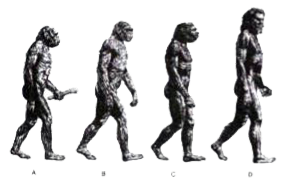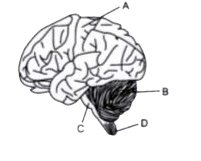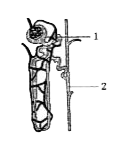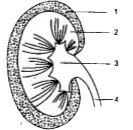Identify the group of animals that exhibit the following characters .
(i) Two parts of limbs , adapted for walking running , climbing burrowing , swimming or flying .
(iii) External ears of pinnae are present
(iv) They are viviparous with few exceptions .
Reptilia
Aves
Amphibia
Mammalia
The correct Answer is:D
To identify the group of animals that exhibit the specified characteristics, we will analyze each characteristic step by step.
Step 1: Analyze the First Characteristic
The first characteristic states that the animals have "two parts of limbs, adapted for walking, running, climbing, burrowing, swimming, or flying."
- Many animals have limbs that can be categorized into forelimbs and hindlimbs.
- These limbs are versatile and can adapt to various modes of locomotion.
Hint: Think about animals that have limbs capable of multiple functions.
Step 2: Analyze the Second Characteristic
The second characteristic mentions "external ears of pinnae are present."
- Pinnae are the external parts of the ears that help in sound collection.
- This feature is commonly found in mammals.
Hint: Consider which groups of animals typically have external ears.
Step 3: Analyze the Third Characteristic
The third characteristic states that "they are viviparous with few exceptions."
- Viviparous animals give birth to live young rather than laying eggs.
- While most mammals are viviparous, there are exceptions like the platypus, which is oviparous.
Hint: Recall which animal groups are known for giving live birth.
Step 4: Eliminate Incorrect Options
Now, we will look at the given options: bacteria, apes, amphibians, and mammals.
- Bacteria: These are single-celled organisms and do not have limbs or ears.
- Apes: While they have limbs and are viviparous, they do not have external ears like pinnae.
- Amphibians: They have limbs but typically do not have external pinnae and are not exclusively viviparous.
- Mammals: They have limbs adapted for various functions, possess external ears, and are primarily viviparous.
Hint: Compare each option against the characteristics to find the best match.
Step 5: Conclusion
Based on the analysis, the group of animals that exhibit all the specified characteristics is Mammals (Mammalia).
Final Answer: Mammals (Mammalia)
The first characteristic states that the animals have "two parts of limbs, adapted for walking, running, climbing, burrowing, swimming, or flying."
- Many animals have limbs that can be categorized into forelimbs and hindlimbs.
- These limbs are versatile and can adapt to various modes of locomotion.
The second characteristic mentions "external ears of pinnae are present."
- Pinnae are the external parts of the ears that help in sound collection.
- This feature is commonly found in mammals.
The third characteristic states that "they are viviparous with few exceptions."
- Viviparous animals give birth to live young rather than laying eggs.
- While most mammals are viviparous, there are exceptions like the platypus, which is oviparous.
Now, we will look at the given options: bacteria, apes, amphibians, and mammals.
- Bacteria: These are single-celled organisms and do not have limbs or ears.
- Apes: While they have limbs and are viviparous, they do not have external ears like pinnae.
- Amphibians: They have limbs but typically do not have external pinnae and are not exclusively viviparous.
- Mammals: They have limbs adapted for various functions, possess external ears, and are primarily viviparous.
Based on the analysis, the group of animals that exhibit all the specified characteristics is Mammals (Mammalia).
Topper's Solved these Questions
- BOOK - AAKASH SERIESCHAPTER - ANIMAL KINGDOM EXERCISE - EXERCISE -III (Previous AIPMT/NEET Questions)35videos
ANIMAL KINGDOM
- BOOK - AAKASH SERIESCHAPTER - ANIMAL KINGDOM EXERCISE - EXERCISE -II (MAMMALIA)21videos
ANIMAL KINGDOM
- BOOK - AAKASH SERIESCHAPTER - BIODIVERSITY AND CONSERVATIONEXERCISE - EXERCISE-II India - A major Source of Biodiversity and its Preservation2videos
BIODIVERSITY AND CONSERVATION
Similar Questions
Carefully observe the figure and then answer the questions that follow :
 (i) Identify the ancestors of humans shown in the figure.
(i) Identify the ancestors of humans shown in the figure.
(ii) Write any two characters of each A and C.
(iii) What is the cranial capacity of B ?
(iv) What is the height of D ?
(v) What type of teeth does D had ?View SolutionThe following diagram represents the human brain as seen in an external view. Study the same and then answer the questions that follow :

(i) Name the part labelled A, B, C and D.
(ii) Mention the difference in the arrangement of the nerve cells in the parts marked 'A' and 'D'
(iii) What is the main function of the parts marked 'C and 'D'?
(iv) Name the sheet of nerve fibres that connect the two halves of the part labelled.
(v) Name the basic unit of brain.View Solution
Knowledge Check
- Question 1 - Select One
Read the following statements and select the option which identifies the incorrect ones.
(i) Potato spindle tuber disease and Chrysanthermum stunt disease are caused by viroids.
(ii) T4 bacteriophage exhibits lytic cycle.
(iii) Retroviruses have two copies of ssRNA.
(iv) Interferous which prevent viral multiplication are glycolipid particles.Aii and iiiBi and ivCiii onlyDiv only - Question 2 - Select One
Following are given four statements (i)- (iv) related to frog. Read the statement carefully and select the option that identifies two correct statements.
(i) The brain in divided into fore-brain, mid-brain and hind-brain
(ii) Vasa efferentia enter the kidneys on their side and open into Bidder's canal
(iii) Ear acts as a hearing organ only
(iv) RBCs are enucleated and contain red coloured pigment namely haemoglobinA(ii) and (iii)B(i) and (ii)C(iii) and (iv)D(i) and (iv)
The diagram given below is that of a structure present in a human kidney. Study the same and answer the questions that follows :

(i) Name the structure represented in the diagram.
(ii) What is the liquid entering part T called? Name two substances present in this liquid that are reabsorbed in the tubule.
(iii) What is the fluid that comes to part '2' called? Name the main nitrogenous waste in it.
(iv) Mention the three main steps involved in the formation of the fluid mentioned in (iii) above.
(v) Name the substance which may be present in the fluid part '11 if a person suffer from diabetes mellitus.View SolutionHow many of the following statements (s) are correct ?
(i) Genus comprises a group of related species which has more characters in common in comparison to species of other genera .
(ii) 'pardus' and 'leo' are two different species but both belong to the genus Felis.
(iii) Each genus may have one or more than one specific epithets representing different organisms .
(iv) A species is a group of individuals with highest fundamental similarities and maximum number of organisms.View SolutionThe diagram given below shows a section of a human kidney. Study the diagram carefully and answer the questions that follow:

(i) Label the parts numbered 1 to 4.
(ii) Why does part "2" have a striped appearance?
(iii)What is the fluid that passes down part:'4' ? Name the main nitrogenous waste present in it.
(iv) Mention the structural and functional unit of kidneys.
(v) Name the two major steps in the formation of the fluid mentionedView SolutionRead the following statements about animal tissue . Identify the true and false ones and select the correct option .
I. Adhering junctions along with cementing cell together facilitate the cells to communicate with each other by connecting the plasma
II. Compound epithelium covers the moist surface of the buccal cavity. Pharynx and lining of ducts of salivary glands.
III. The striated muscle fibre is a thin elongated with point ends and multiple nuclei
IV . Cartilage is present in the tip of the nose and between the bodies of adjacent vertebrae.View SolutionSelect the option with a correct representation of an animal belonging to the below mentioned class of vertebrates.
I. The notochord is persisitent throughout life. The mouth is ventral.
II. The skin is moist without scales . The tail may be present.
III. 6 to 15 pairs of gill slits. Jaws absent.
IV. Viviparous usually. pinna present in most of the members.View SolutionConsider the following statements (i-iv) each with two blanks .
(i) Jellyfish exhibits (A) symmetry whereas cuttle fish exhibits (B) symmetry .
(ii) Incomplete gut is present in (C ) whereas complete gut is present in (D)
(iii) Closed circulatory is present (E ) whereas open circulatory system is present in (F)
(iv) Flatworms are (G) whereas roundworms are (H)
Which one of the following options , gives the correct fill - ups for both the blank numbers one of the above statements ?View Solution

